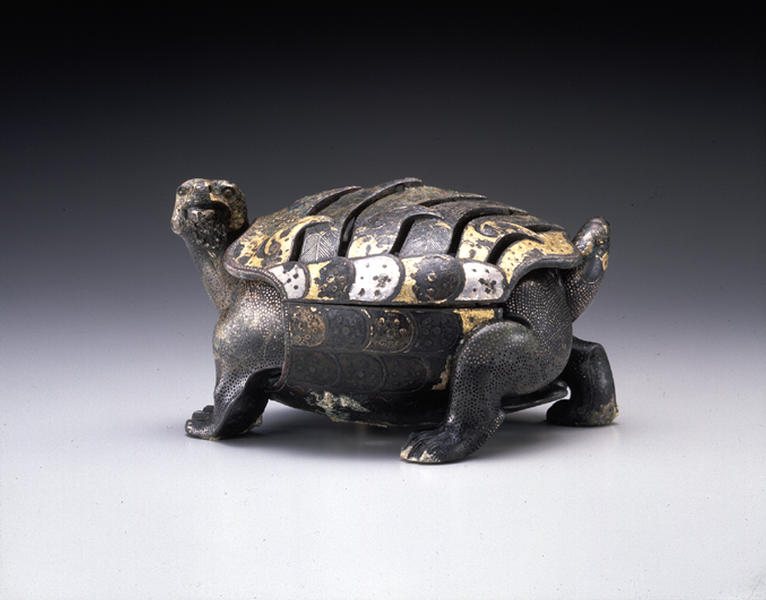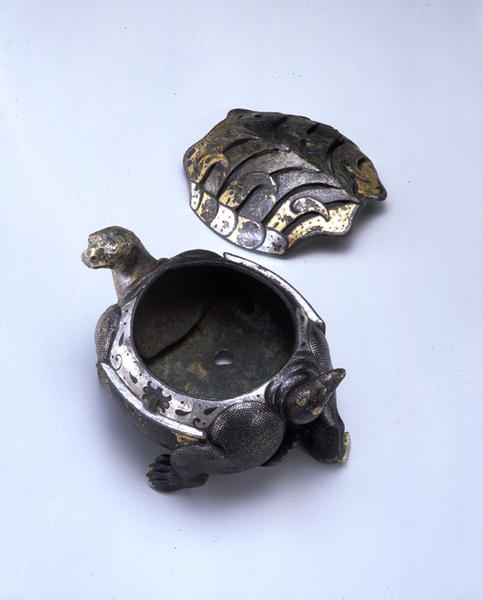Incense Burner in the Shape of a Tortoise
- China
- China, Han period
- 3cB.C.-3A.D.
- Bronze, gold, silver
- D-11
Catalogue Entry
This bronze tortoise appears to stop for a moment, taking a break from a slow walk, with the right legs pulled back and the left legs pushed forward, and with the head lifted up to the left. The tail is directed to the upper right. The openworked shell is removable, like a lid, and a hole is made at a side of the center ridge, where the center of gravity of the lid is presumed to be, perhaps to allow a string to be attached through it. There appear to be traces of damage caused by a chain link at the top of its head, suggesting that the head and the lid might have been chained together. The inside of the lid and the body of the tortoise, which the lid covers, fit snugly by means of a tongue and groove joint. The bottom is provided with three irregularly shaped ventilating holes.
Tiny silver dots are inlaid on the surface of the four legs, which have strong claws, and on the stout neck to mimic reptile skin; the realistic face and the tail are covered with gold, and translucent, brownish, round stones are placed in the eye holes. In the under shell, the grooves are shown by wavy lines of silver inlay. Small as it is, the magnificent body filled with power from head to tail communicates the solemnness and awe of a sacred tortoise.
The area where the lid meets the rest of the figure is adorned with a decorative scale pattern and seven-eyes like motif one row on the lid and two rows on the body. The shell is strikingly unusual; it is represented by silver wire inlay, which makes a linear flow that appears sharp at the center. Either side of the shell is adorned with designs in gold inlay which resemble a curved bird's beak. Both the front and rear ends of the shell provide a grainy texture executed in gold inlay. This openwork shell design is reminiscent of the cloud spirit, manifested as fantastic bird and dragon designs, on herb vessels and censers dating back to the period of Warring States, such as those found in tombs in Wangshan Jianglingxian, and Zeng Hou Yi, Hubei Province.*1
In the Han period (206 B.C.-A.D. 220), censers were generally produced with a lid sculpted to resemble a sacred mountain, and, frequently, the support was carved with a design of a tortoise or a Chinese phoenix. Censers made in the shape of an animal are relatively rare, though examples are known from excavations in Shanxi, Henan, and Hubei Provinces.*2 The present figure is not only rare but remarkable in that an animal-shaped censer was made with such care and interest in realism, far surpassing the need dictated by utility for daily life.
From the time of antiquity, the tortoise has been regarded as a sacred animal that possesses knowledge about future outcomes or events, and it was believed that prosperity would bless a household if the family obtained a particularly auspicious specimen. A commonly-held image of a tortoise as a messenger from a deity called for a tortoise that was fist-sized, gold in color, with the edges of both sides of the shell serrated like saw teeth and claws that were extremely sharp. It was also said that hair begins to grow on a tortoise after it is 1000 years old and, when it is 5000 years old, it was to be regarded as sacred.*3 It may not be too far off the mark to say that the artist summoned an aggregation of such images about the tortoise when creating this rather realistic golden censer in a tortoise shape.





